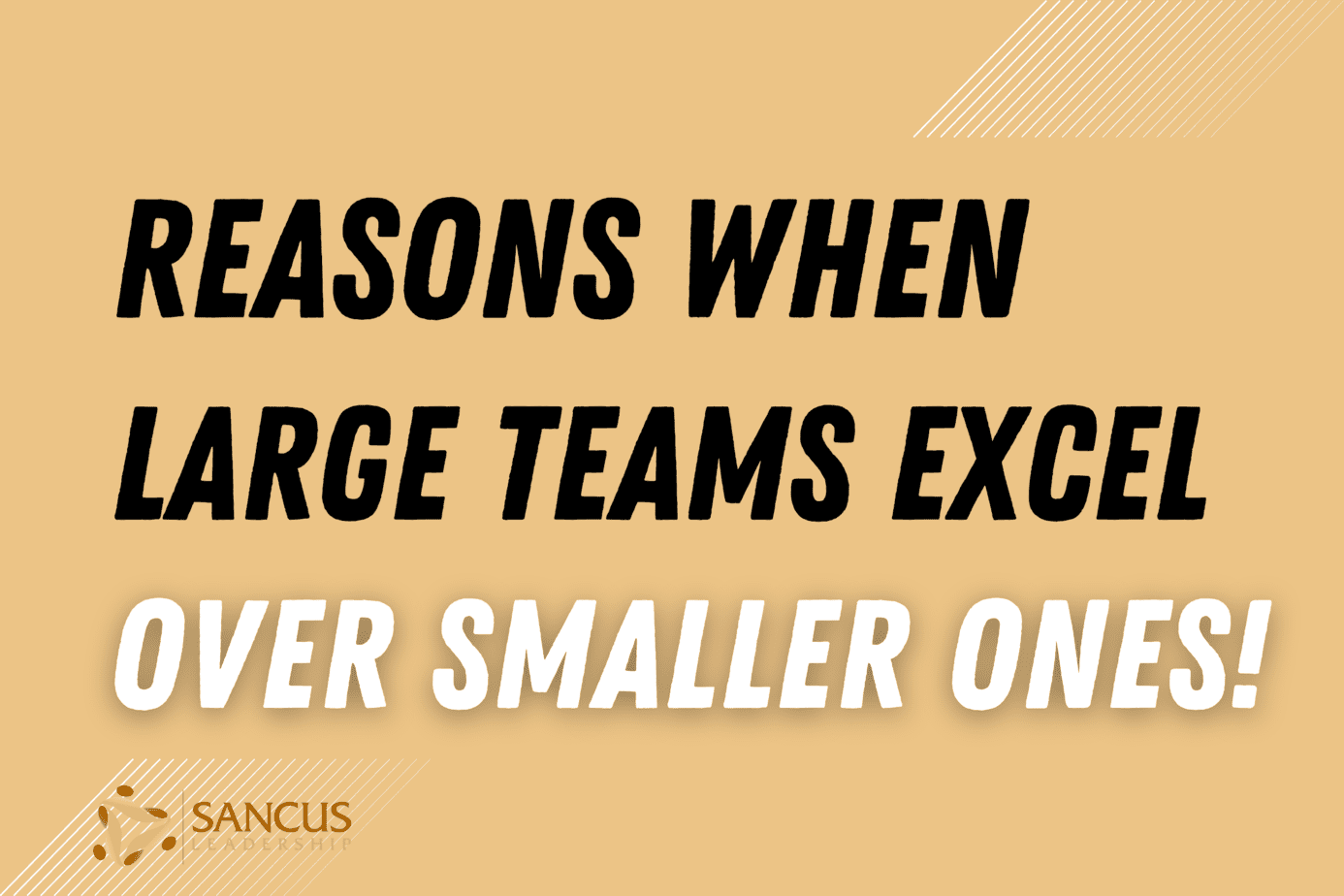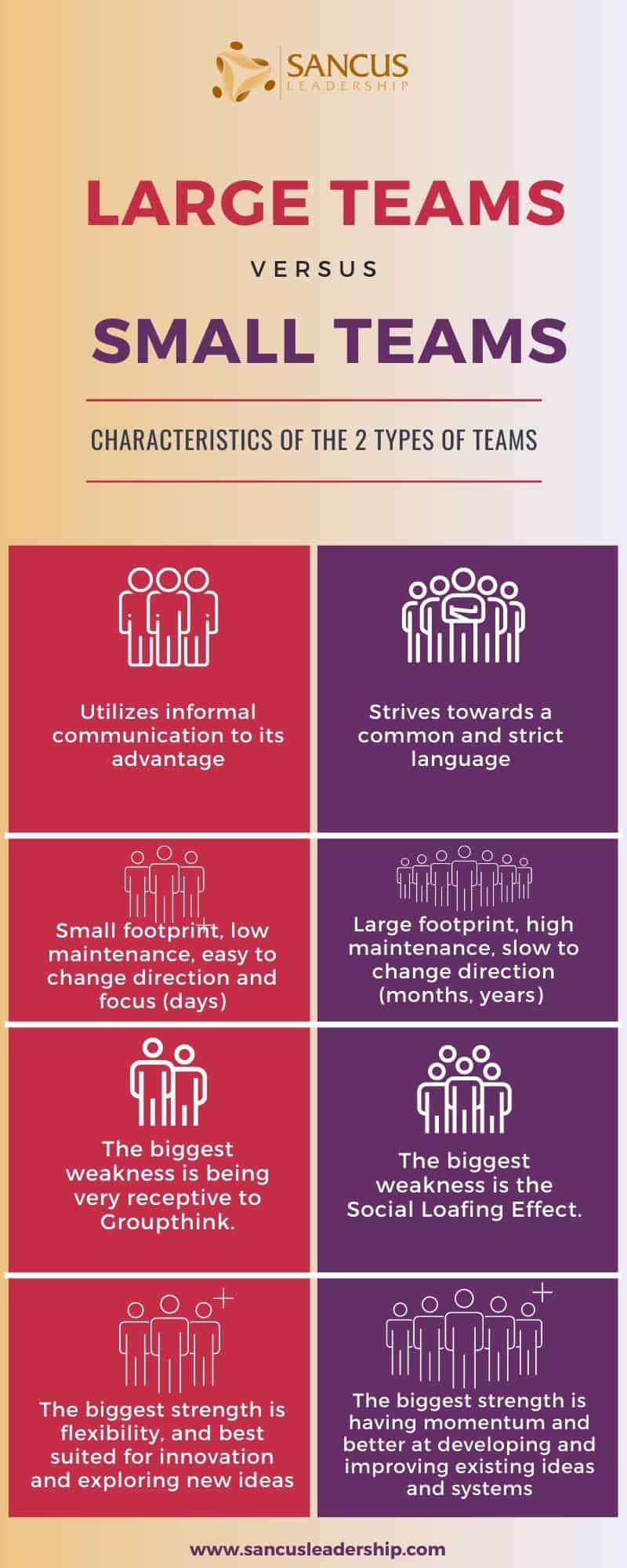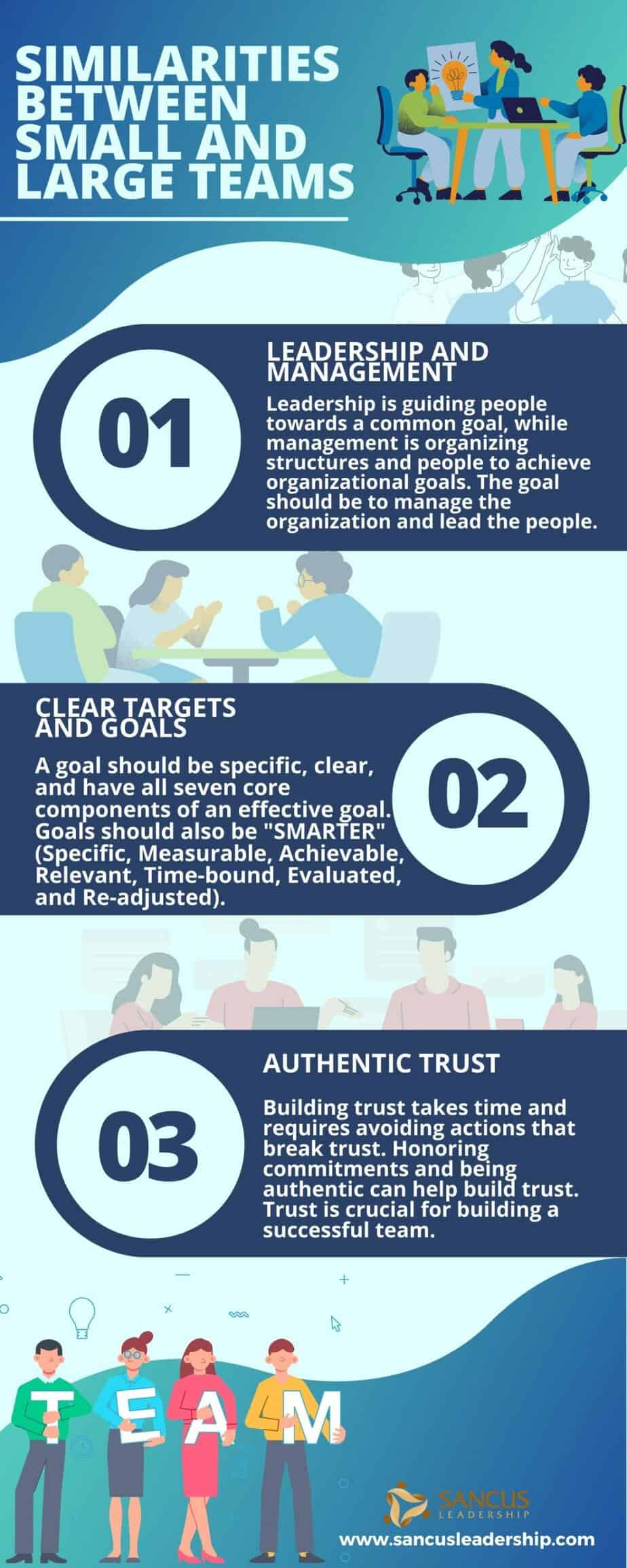Your cart is currently empty!

Why and When Large Teams Outperform Small Ones!
I have spent my time as a leader at both the top and the bottom of organizations, and one of my main takeaways is the difference in team structure, behavior, and task performance depending on team size.
I have seen managers figure this out and become great leaders. And I have also seen the opposite, where great leaders become horrible managers just because they don’t understand the differences in leading a different-sized team.
Today I want to combine my thirteen years of experience with leadership science so that we can learn two things; When do small/large teams perform best, and how do we best lead small/large teams?
What Is A Small Team?

The definition of a small team differs in the area where it is used; in research, a small team is defined as a team of two to three members, while in the business community, a small team is between two to ten members.
For the purpose of this article, we will define a small team in line with the business community, up to ten people.
Now that we have figured out how we define small, we must also look at what a team is.
A team is a group of individuals (human or non-human) working together to achieve their goal.
https://en.wikipedia.org/wiki/Team
Worth noticing here is that if you don’t have a common goal that people are working together towards, then you only have a group of people, not a team. This difference is vital when it comes to team performance. Use this definition to ask yourself if you are on a team or amongst people in a group.
Use this definition to ask yourself if you are on a team or amongst people in a group.
What Is a Large Team?

The definition of a large team differs in the area where it is used; in research, a large team is often defined as a team of more than three members, while in the business community, a large team is between 10 and 20 members.
Some would argue that teams can be up to 50 people (Harvard Business Review), but I’m afraid I have to disagree. As mentioned above, one of the definitions of a team is the ability to work together towards a common goal.
One of the greatest challenges of any leader is to clearly communicate the goals so that members understand the why and what needs to be achieved.
Without this clear understanding, people can’t work together. And in a team that is too big, this becomes almost impossible, at least in an environment as complex as a business.
Therefore, the limit of a large team is drawn to twenty people, and dividing the group into smaller teams is vital.
The larger an organization, the greater the chance of inconsistency
State of American Workplace 2020
and misalignment. Managers may be responsible for more employees
than they can support effectively.
The Interesting Differences Between Small and Large Teams

Now that we have understood the differences let’s start comparing team sizes to understand what team is appropriate for what tasks and how we, as leaders, should lead!
Differences in Team Characteristics
Firstly, let’s compare the differences in team behavior. To lead, we must first understand the creature that we are leading!
It probably doesn’t come as a surprise to you that small teams are more flexible and can adapt to ideas at a much faster speed. Like the difference between a giant container ship versus a small speed boat trying to change course on the ocean.
But what does this mean for task performance?
Our analyses uncovered a nearly universal pattern: … [Small teams] tended to disrupt current ways of thinking with new ideas, inventions, and opportunities.
hbr.org
Harvard Business Review discovered in their research that this ability to change course means that small teams can use new information to impact processes and decision-making MUCH faster than larger, slower teams. But what does this mean for task performance?
This is partly to blame for the second big difference between small and large teams.

Small Teams Accept and Communicate Ideas Faster
If you have a new and challenging idea of how to do something different, one of the most significant challenges is getting your team’s acceptance of that idea. Change is difficult and painful so this resistance to change is a good safety mechanism.
And by the end of the day, most new ideas are bad, but that’s a discussion for another day.
The best way to get someone to accept your idea is that they can see the benefit, and for you to communicate in a way that each individual understands the benefit, you must first understand them as individuals.
Here’s where the large team runs into problems; the leader can’t understand and know all of his/her members, so communications must be generalized. This leads to a lower chance of acceptance (unless you are Simon Sinek).
But on the small team, you speak with individuals in a way you know they understand information. And you can instantly address objections! This is the true power of small teams, understanding what your people need!
Once the idea is accepted, it is time for the next challenge, accessing the infrastructure.
Large Teams Demand Big Logistical Chains
The incredible power of a large team is once it is lined up in the right direction, like the tanker ship mentioned before, there is no storm out there that can stop it. The team has enormous resources (people, time, gear) that can be utilized toward the goal once the goal is understood.
Spiderman’s Uncle Ben said, “With great power comes great responsibility.” The same goes with handling large teams – with great power comes considerable logistical demands.
Directional changes in small teams require less financial investment, less time, and less management.
If you have a team of ten and want to switch up your hardware to solve a task your old gear can’t, then it’s half the cost of a twenty-man team. This means a more extensive investment and more challenging to convince upper management that it is a good idea.
And if the idea fails (which most new ideas do), well… you get the point.
Team Size Impacts Weakness
One of the most incredible benefits of small teams is their ability to build authentic trust fast! This is one of the core principles of effective small-team leadership and should be exploited to its maximum.
But the downside is that it tends to move the team into Groupthink, where the members trust each other so much that they stop questioning ideas and thoughts.
This is bad…
It leads to single-minded thinking, kills the creativity that small teams are known for, and tends to create an extremist view of “us and them.”
On the other hand, larger teams have a built-in function due to their size that inhibits people from getting to know each other well, making building deep trust with everyone difficult.
This means there will always be some resistance to ideas and suggestions since they are not automatically accepted (which happens with deep trust).
If the large team can encourage free speech, then the issue of Groupthink is basically eliminated.
Large teams are more likely to have coordination and communication issues.
hbr.com
So now we know what to avoid, let’s look at what to exploit!
Team Size Impacts Strength
One fundamental principle of outstanding leadership is understanding your team’s strength and leveraging it to the moon!
While small teams can be agile and change direction fast when opportunities arise, large teams can hold a steady course and outweigh any sudden short-term trends.
A small team’s ability to quickly adapt enables it to innovate and explore new ideas without investing too heavily. A downside is, of course, a sometimes haphazard and directionless wandering of the team.
Smaller teams allow for greater accountability, autonomy, and flexibility, both in terms of scheduling- and idea-based changes. They “foster greater trust among team members and less fear of failure.” (doist.com)
As discussed earlier, most new ideas fail, so this constant change of direction can often leave certain employees feeling aimless and lost. Without a competent leader, these teams tend to pick up new ideas too often and abandon them too soon.
On the other hand, the large team implements new ideas more slowly and less frequently since it takes time to get the message across and understood by the team.
On a Large team, once the goal is clarified, the team is on board, and the processes are set, the team will improve and implement ideas with much less fluctuation. The team members can, therefore, better understand their role and anticipate future obstacles allowing for greater efficiency in execution.
If life on a small team is chaotic and fast (the speedboat), then large team life is robust and efficient (the ocean tanker).
If life on a small team is chaotic and fast (the speedboat), then large team life is robust and efficient (ocean tanker).
In summary: small teams are best suited for innovation and exploring new ideas, while large teams are better at developing and improving existing ideas and systems.
| Differences in Team Characteristics | Small Team | Large Team |
| Communication | Utilizes informal communication to its advantage | Strives towards a common and strict language |
| Logistics | Small footprint, low maintenance, easy to change direction and focus (days) | Large footprint, high maintenance, slow to change direction (months, years) |
| Biggest Weakness | Very receptive to Groupthink | The Social Loafing Effect |
| Biggest Strength | Flexibility Change team culture and accept new ideas fast. | Momentum Once lined up with the goal, few things can hinder its progression. |
| Most Effective Task | Innovate | Develop |
Differences in Leadership Between Small and Large Teams
As we have come to understand, the size of a team impacts what tasks are most suitable, and if the task changes, so must also the leadership.
Suppose the manager doesn’t understand the differences in leadership needed between running a small and a large team. In that case, chances are they’ll end up, as the example I mentioned in the beginning, without trust and with a lot of friction.
Manager quality influences engagement more than team size does.
Gallup.com
Once the leader understands the opportunities that come with different team sizes, then he or she can exploit those to reduce misunderstandings and employees’ eating time on solving the wrong tasks.
I think we have all issued a “task order,” and once we got the results back, we realized, “this is not at all what we were expecting.”
Small Team Leadership
So what should the small team leader focus on?
Effective small-team leadership is characterized by understanding every team member as an individual with different needs and strengths. The small team leader should focus on building authentic trust and leveraging employees’ inner drive to achieve synergy and long-term retention.
The most significant benefit of the small team leader is the amount of one on one face time possible. If done correctly, this can 10x the speed it takes to build profound trust and understanding between the leader and team member.
Did you know that managers account for at least 70% of the variance in team engagement and heavily influence employee wellbeing? This is the reason why employees don’t leave companies — they leave managers.
Gallup.com
I would suggest you avoid classic team-building activities like playing a game and getting drunk. What you want to do is Forge Trust through adversity and challenge, which is something that is (or should be) happening during your workweek. (email me if you want some examples of how this can be done)
Most small team leaders I talk to, and I agree with this, say that the greatest challenge is making decisions that you know will negatively impact a team member’s life.
This is the dark side of knowing and truly understanding your people. On a large team, there isn’t enough time to get to know individuals in the same way, so tasks such as “letting people go” are often easier.
Large Team Leadership
Leading a large team is usually simpler, not to be confused with easy, but it tends to be more managing and less leading.
Effective large team leadership is characterized by focusing on clearly communicated and followed processes, leading a unit rather than individuals, and maintaining a “sufficiently distanced relationship” with the team members.
The greatest benefit of the large team leader is the ability to detach from emotions and make more balanced decisions.
Many managers fail and get overly detached, making inhumane decisions. Pushing the employees too far away will sooner or later make them look for another job or, even worse, silently quit.
If you, as a large team leader, find a good point of balance, and you keep close enough to understand their needs but not close enough to get too heavily attached, then you are in a great position to make effective decisions that benefit the organization and the employee long term.
I have seen too many leaders fall into the trap of giving the employees what they want today instead of giving them what they need for tomorrow.
I have seen too many leaders fall into the trap of giving the employees what they want today, instead of giving them what they need for tomorrow.
An example would be allowing people to go home one hour early because it would be nice, instead of taking that hour and training them in something that will benefit their career or life at a later stage.
Your job as a leader is to guide your people and organization towards a brighter tomorrow, not give in to the temptations of today.
| Differences in Leadership | Small Team | Large Team | Notes |
| Communication | Understanding the individual | Uniform language | |
| Greatest Leadership Difficulty | Finding harmony between organizational goals and employee sense of meaning | Building authentic trust | |
| Greatest Leadership Benefit | Building authentic trust fast | Easier decision-making* | *Decision that will impact employees negatively but benefit the organization is easier with “distanced leadership.” |
| Main Effort of The Leader | Understand the individual | Understand the team as “one organism.” |
Our analyses uncovered a nearly universal pattern: whereas large teams tended to develop and further existing ideas and designs, their smaller counterparts tended to disrupt current ways of thinking with new ideas, inventions, and opportunities.
hbr.org
The 3 Vital Similarities Between Small and Large Teams

So far, we have mainly discussed differences, but just as between men and women, there are significant differences, even if we are mostly the same. Here are the three most important similarities you need to consider as a team leader.
1. All Teams Must Be Led and Managed Simultaneously
The difference between managing and leading is a discussion for another day. Still, for the purpose of this article, I will define leading as the act of guiding humans towards a common goal and managing as organizing structures and people to achieve organizational goals.
Nobody wants to be managed, especially micro-managed. So our job as managers is to become as much of a leader as possible while still managing what needs to be managed.
Our strive should be to manage the organization and lead the people. If we don’t, and we start treating people as material possessions of the company, then we are setting ourselves up for failure as a team leader and organization.
But when we find the balance, we can create teams that achieve high performance over many years, just like I did with my last team, working together daily for 4+ years, something that has yet to be seen in my organization.
If we fail, we get people who silently wait or look to get another job.
Lead your people and manage the organization.
Large team leaders will need to lean more towards managing, and small team leaders will rely more on leading, but both will need to be excellent at specifying and communicating goals.
2. All Teams Need Clearly Specified and Communicated Targets and Goals!
As we discussed earlier, the difference between a group of individuals and a team partly lies in the ability to work towards a common goal. So how do you make a goal common?
A big mistake many managers make is they think just because an idea is obvious to them and they have already presented it to the team on a PowerPoint slide; then everyone must get it, right?
There are so many mistakes being made here. Firstly, most people don’t even listen to PowerPoint presentations. Secondly, even if they did, most managers don’t know what a goal really is, much less know EXACTLY and SPECIFICALLY what their team goals are. So how can you communicate something clearly if it isn’t clear?
Well, you can’t exactly. So the first part must be to get so specific and clear that your goal can be presented in one single sentence, and it needs to have all the seven core components of an effective goal.
A good start is to make sure your goals are “SMARTER”!
3. Must Build Authentic Trust
Trust has been a trendy word in the leadership community for many years. I just googled “build trust on your team,” and supposedly, there are over 10k searches each month in the US alone for this specific search term.
But what does it really mean? Trust is very complex but also something very simple and straightforward. You know if you trust someone, but it’s not always clear exactly why.
But you usually know exactly why you DON’T trust someone. They may have let you down, not kept their word, or somehow made you feel inferior.
The same goes for trust in a team. You want to be the person people feel they can trust even though they don’t know exactly why, and you must definitely avoid everything that makes people know why they don’t trust you!
If you lack trust, you don’t have a team. It’s that simple.
Building authentic trust can be challenging and may take time. But start by avoiding the pitfalls mentioned above, honor your word, make commitments, and accept that you will sometimes fail.
We trust the people whose actions we can anticipate. It matters less who you are than that you are authentic. People will accept your flaws if you accept theirs.

Conclusion
In short, large teams are great at developing existing ideas, while small teams excel at innovation.
Small team leadership focuses on understanding the individual’s strengths and leveraging them to achieve a high-performing team. Large team leadership, on the other hand, emphasizes the team as “one cohesive organism.”
